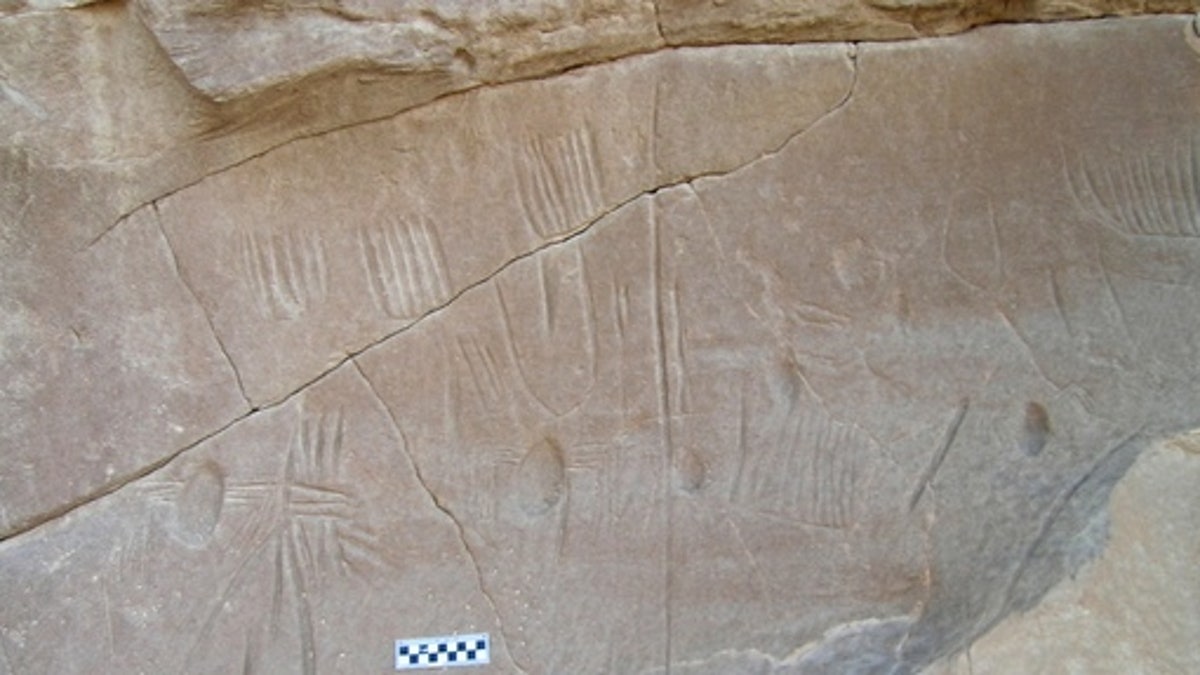
Archaeologists have discovered a broken panel that depicts the only known example of spider rock art in Egypt and, it appears, the entire Old World. (Photo by Salima Ikram, North Kharga Oasis Survey, cropped by Owen Jarus.)
Archaeologists have discovered a panel containing the only known example of spider rock art in Egypt and, it appears, the entire Old World.
The rock panel, now in two pieces, was found on the west wall of a shallow sandstone wadi, or valley, in the Kharga Oasis, located in Egypt's western desert about 108 miles west of Luxor. Facing east, and illuminated by the morning sun, the panel is a "very unusual" find, said Egyptologist Salima Ikram, a professor at the American University in Cairo who co-directs the North Kharga Oasis Survey Project.
The identification of the creatures as spiders is tentative and the date of it uncertain, Ikram told LiveScience in an email. Even so, based on other activity in the area, the rock art may date to about 4000 B.C. or earlier, which would put it well into prehistoric times, before Egypt was unified, noted Ikram, who detailed the finding in the most recent edition of the journal Sahara. [See Photos of the Newfound Spider Rock Art]
The main panel shows what appear to be a few spiders, with a "star" that's possibly meant to depict a web next to the spider on the far left. There are also comblike drawings that are more enigmatic; Ikram said they could be insects being trapped by the spiders, plants or even silken tubes spun by the spiders.
A piece of rock that appears to have been broken off the main panel depicts creatures drawn in a different style, their limbs not flexed, but rather have a flat appearance. This could be an attempt to portray a harvestman, an insect that looks like a spider.
The discovery leaves archaeologists with a mystery why did people in the Kharga Oasis create rock art showing spiders, especially when no other examples are known to exist elsewhere in Egypt or, it appears, the entire Old World?
Why spiders?
There is little evidence the ancient Egyptians had much interest in drawing spiders. The only spider hieroglyphs that Ikram knows of are rare examples from "religious texts dealing with the so-called 'Opening of the Mouth' ritual, a rite that was performed on the mummy or a statue to restore its senses for use in the Hereafter."
The secret to solving the mystery may lie more in the western desert itself. Ikram consulted with Hisham El-Hennawy, an arachnologist who mentioned spiders called Argiope lobata living in the western and eastern deserts may have attracted the interest of ancient people. These spiders can be found "shaded and surviving, in the middle of their orb web under the burning sun at Noon," Ikram writes.
The idea of spiders bathing in the sun may hold religious significance to ancient people in the area. "This would combine the force of the sun and the ability of this solar creature to survive its heat successfully, and thus be worthy of reverence or totemic allegiance," she writes in the Sahara article.
In addition, some spiders in Egypt are known to bite people and pose a danger, something that may have attracted ancient interest, and hence, the creepy-crawly rock art, Ikram said. It's also possible that spiders were more prevalent in the oasis in the past, something the environmental research her team is conducting may shed light on. Another possibility is that whoever drew these depictions didn't have a special reason in mind but just felt, for whatever reason, like trying to draw spiders. Spiders are of interest for several cultures around the world, she noted.
Whatever the reasons were for creating the spider rock art, the ancient people of the oasis left something unique behind, in a creepy-crawly way. These "images are noteworthy if they are indeed spiders, as these would be unique depictions of such creatures in Old World rock art," writes Ikram.
Copyright 2013 LiveScience, a TechMediaNetwork company. All rights reserved. This material may not be published, broadcast, rewritten or redistributed.
